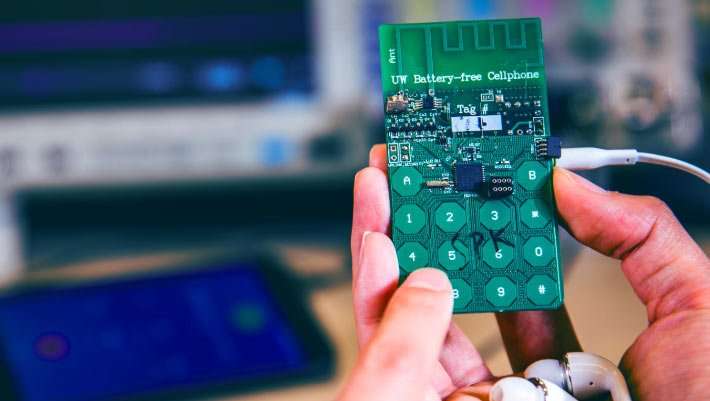A team of computer scientists and electrical engineers at the University of Washington has invented a cellphone that requires no batteries and harvests power from either ambient radio signals or light. The device is described in a paper published in the Proceedings of the Association for Computing Machinery on Interactive, Mobile, Wearable and Ubiquitous Technologies.
“We’ve built what we believe is the first functioning cellphone that consumes almost zero power,” said co-author Dr. Shyam Gollakota, from the Paul G. Allen School of Computer Science & Engineering at the University of Washington.
“To achieve the really, really low power consumption that you need to run a phone by harvesting energy from the environment, we had to fundamentally rethink how these devices are designed.”
Dr. Gollakota and co-authors eliminated a power-hungry step in most modern cellular transmissions — converting analog signals that convey sound into digital data that a phone can understand.
This process consumes so much energy that it’s been impossible to design a phone that can rely on ambient power sources.
Instead, the battery-free cellphone takes advantage of tiny vibrations in a phone’s microphone or speaker that occur when a person is talking into a phone or listening to a call.
An antenna connected to those components converts that motion into changes in standard analog radio signal emitted by a cellular base station.
This process essentially encodes speech patterns in reflected radio signals in a way that uses almost no power.
To transmit speech, the phone uses vibrations from the device’s microphone to encode speech patterns in the reflected signals.
To receive speech, it converts encoded radio signals into sound vibrations that that are picked up by the phone’s speaker.
In the prototype device, the user presses a button to switch between these two ‘transmitting’ and ‘listening’ modes.
“The cellphone is the device we depend on most today. So if there were one device you’d want to be able to use without batteries, it is the cellphone,” said senior author Professor Joshua Smith, from the Allen School and the Department of Electrical Engineering at the University of Washington.
“The proof of concept we’ve developed is exciting today, and we think it could impact everyday devices in the future.”
The battery-free phone does still require a small amount of energy to perform some operations. The prototype has a power budget of 3.5 microwatts.
The team demonstrated how to harvest this small amount of energy from two different sources.
“The battery-free device prototype was built using commercial-off-the-shelf components on a printed circuit board,” the researchers said.
“It can operate on power that is harvested from RF signals transmitted by a basestation 31 feet (9.4 m) away.”
“Further, using power harvested from ambient light with tiny photodiodes, we demonstrated that our device can communicate with a basestation that is 50 feet (15.2 m) away.”
The authors demonstrated that the prototype can perform basic phone functions — transmitting speech and data and receiving user input via buttons.
Using Skype, they were able to receive incoming calls, dial out and place callers on hold with the battery-free phone.
“We designed a custom base station to transmit and receive the radio signals. But that technology conceivably could be integrated into standard cellular network infrastructure or Wi-Fi routers now commonly used to make calls,” they said.
“You could imagine in the future that all cell towers or Wi-Fi routers could come with our base station technology embedded in it,” said firstr author Dr. Vamsi Talla, also from the Allen School at the University of Washington.
“And if every house has a Wi-Fi router in it, you could get battery-free cellphone coverage everywhere.”
The team now plans to focus on improving the battery-free phone’s operating range and encrypting conversations to make them secure.
Vamsi Talla et al. 2017. Battery-Free Cellphone. Proceedings of the ACM on Interactive, Mobile, Wearable and Ubiquitous Technologies 1 (2): 25; doi: 10.1145/3090090
This article is based on text provided by the University of Washington.

aexeron on July 16th, 2017 at 08:14 UTC »
I mean while the concept is neat, I highly doubt any reasonable amount of power could be harvested from stray EM radiation unless you had a high powered transmitter literally within a few feet. Furthermore, using photodiodes to generate power from light? We have solar panels that are leagues better at generating electricity.
Overall, a neat concept, but limited application so far.
markusbrainus on July 16th, 2017 at 07:28 UTC »
Is this not how a crystal AM radio works? We've had this for 100 years. You can use an unpowered high impedance earbud attached to a passive bandpass filter to listen to AM radio. ex: http://www.ke3ij.com/xtal.htm
Presumably you can run it the other way to transmit extremely low power signals by using the acoustic power in your voice applied to the piezoelectric crystal to power the antenna. Unfortunately the other person listening would probably have to be in the same room to have any hope of receiving the signal... We need more power to boost the signal and for any digital processing.
217to707 on July 16th, 2017 at 06:54 UTC »
So currently it is a short range walkie talkie?